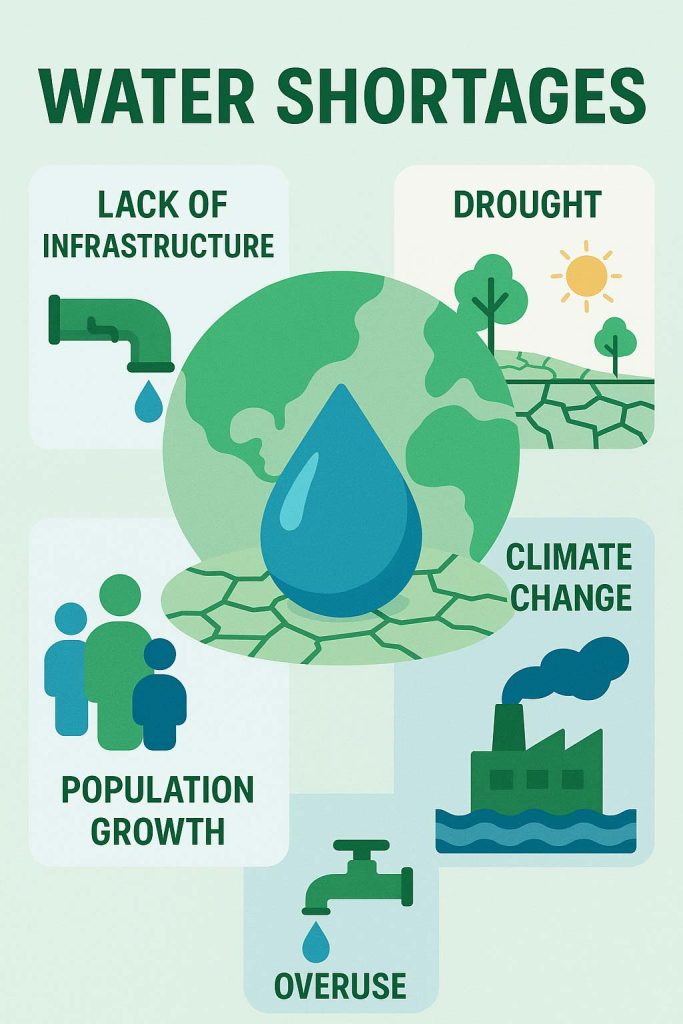Written By: David Cosseboom | Updated On: June 12th, 2025
Water, and especially clean water is an essential part of our lives. We rely on it to survive. We drink it, bathe in it, grow food with it and cook with it, just to name a few a few ways we use water on a daily basis. In the United States, we sometimes take clean water for granted. We turn on our water faucet and assume the water is clean, but that’s not always the case.
Where Does Our Drinking Water Come From?

Our drinking water comes from a variety of natural sources, primarily surface water and groundwater. Surface water includes rivers, lakes, and reservoirs, where rainwater and snowmelt collect and flow. Groundwater, on the other hand, is found beneath the Earth’s surface in aquifers. Aquifers are porous rock or sediment layers that hold water like a sponge. Rain and snow seep into the ground, replenishing these underground stores over time. Both sources are vital, and many communities rely on a mix of the two to meet their needs.
Before it reaches your tap, water undergoes a thorough treatment process to ensure it’s safe and clean. It’s filtered, disinfected, and tested to remove impurities, bacteria, and contaminants. Nature and human ingenuity work hand in hand to deliver this precious resource to your home, making it easy to enjoy a refreshing glass of water whenever you need it.
Water Filtration Systems
While municipal water systems are typically treated to meet safety standards, contaminants like chlorine, sediment, heavy metals, and even trace amounts of chemicals can still be present. Filtration systems work by removing impurities through physical, chemical, or biological processes, providing an extra layer of protection. They can also improve the taste, smell, and clarity of your water, making it much more enjoyable to drink and use for cooking.
There are several types of home filtration systems to choose from, depending on your needs. Activated carbon filters are popular for reducing chlorine, volatile organic compounds (VOCs), and bad odors. Reverse osmosis systems offer comprehensive purification by removing contaminants like lead, arsenic, and fluoride. Ion Exchange systems are specialized for hard water (calcium/magnesium) and some systems also target heavy metals. For well water users, whole-house filters can target sediment, iron, and bacteria. Many systems are easy to install and maintain, providing you with cleaner water right from your tap. Investing in a filtration system not only enhances your water quality but also gives you peace of mind knowing your family’s health is protected.
Learn More: Which Water Filtration System is Right for Your Home
Pollutants
For many of us, water is a regulated resource, with the responsibility to provide it falling on the local governments. The Safewater Drinking Act, passed in 1974 regulates pollutants and sets standards for levels of contamination from lead, arsenic, copper and many others. Even with these EPA regulations in place, millions of people are exposed to unsafe and polluted drinking water. In the U.S., even though our water is generally well-treated, there are still some common pollutants that can sneak in. Here’s a quick rundown of the usual suspects:
- Lead: Older pipes and plumbing can leach lead into drinking water, especially in homes built before the 1980s. Lead is harmful, especially for kids, affecting brain development.
- Chlorine & Disinfection Byproducts: Wait, isn’t chlorine good? Well, yes, it kills bacteria! But too much can make water taste funny, and when it reacts with organic matter, it can form byproducts like trihalomethanes, which aren’t great in large amounts.
- Nitrates & Nitrites: These often come from fertilizers and agricultural runoff. High levels can be risky for babies, turning into a compound that messes with oxygen in the blood.
- PFAS (Forever Chemicals): These stubborn industrial chemicals don’t break down easily and have been linked to health issues. They’re found in things like non-stick pans, firefighting foam, and even some drinking water supplies.
- Pesticides & Herbicides: Runoff from farms and lawns can bring chemicals like atrazine or glyphosate into water sources. Not something you want in your morning glass of water!
- Mercury: Mostly from industrial pollution, this heavy metal can accumulate in fish and, eventually, in us if we eat too much contaminated seafood.
- Bacteria & Parasites: Think E. coli or Giardia. Usually, treatment plants zap these, but sometimes, especially after heavy rains or in well water, they can slip through.
- Pharmaceuticals: Yep, traces of medicines, from painkillers to hormones, can end up in water after passing through our bodies or being improperly disposed of.
- Sediment & Microplastics: Dirt, sand, and tiny plastic particles (from breaking down bottles and synthetic fibers) are increasingly showing up in water. Not great for ecosystems, or us!
Ever tested your water? It might be worth checking out, especially if you have old pipes or use well water!
Learn More: Which Water Filtration System is Right for Your Home
Find Utility Providers In Your Area
Connect Your Home to Water, Electricity, Natural Gas, Internet and Trash services all in one place.
Water Shortages

Polluted water is not the only water issue we currently face. With increasing populations and decreasing rainfall, water shortages are becoming a reality. The average American uses 80 to 100 gallons of water per day, that’s more than 345 billion gallons a day for the country as a whole. As average temperatures continue to rise that amount will only go up and put further strain on our water resources. Water shortages are a growing concern, not just in far-off places but right here in the U.S. too. It’s one of those things we don’t always think about, until suddenly, there’s a drought, or cities start restricting water use.
What Causes Water Shortages?
- Drought (Nature’s Dry Spell)
- The most obvious culprit! When rain and snowpack are way below normal for months or years, lakes, rivers, and groundwater don’t get replenished.
- Example: The Southwestern U.S. (California and Arizona) has been dealing with a megadrought made worse by climate change.
- Overuse (We’re Using Too Much!)
- Even in places with decent rainfall, if we’re pumping water out faster than nature can replace it, trouble follows.
- Agriculture gulps down about 80% of water in some Western states.
- Cities and industries also play a role, think lawns, golf courses, and manufacturing.
- Groundwater Depletion (Mining Water Like It’s Gold)
- Aquifers (underground water stores) are being drained way too fast in places like the Ogallala Aquifer (Midwest) and Central Valley, California.
- Once these are emptied, they can take centuries to refill.
- Climate Change (The Big Game-Changer)
- Rising temps = more evaporation = less water in rivers and reservoirs.
- Snowpack (a natural water-storage system) is melting earlier, leaving less for summer.
- Extreme weather (like sudden heavy rains) can cause runoff instead of steady replenishment.
- Infrastructure Problems (Leaky Pipes & Old Systems)
- Believe it or not, billions of gallons are lost every year due to crumbling pipes and inefficient systems.
- Cities like Jackson, Mississippi, have faced crises partly because aging infrastructure couldn’t handle demand.
- Population Growth & Urbanization (More People, Same Water)
- Pollution (When Water Exists But Isn’t Usable)
- Contaminants like PFAS, nitrates, or industrial waste can make water unsafe, effectively shrinking the usable supply.
What Can We Do?
- Conservation (fixing leaks, using drought-resistant landscaping, and smarter farming).
- Better Tech (desalination and wastewater recycling).
- Policy Changes (fairer water rights and incentives for sustainable use).
How We Use Water
Of the nearly 100 gallons of water each of use on a typical day, on average 70% of that occurs indoors for things like showering, cooking, drinking, brushing your teeth and many other things. Outdoor use is typically higher in drier areas of the country and is used primarily to water yards and landscapes.
| Where do we use water? | How much do we use? |
| Shower | 20% |
| Faucet | 19% |
| Toilet | 24% |
| Washing Clothes | 17% |
| Water Leaks | 12% |
| Other | 8% |
FAQs About Water for My Home
Is tap water safe to drink?
How is drinking water treated?
Who is responsible for providing my water?
What should I do if my water tastes, smells, or looks unusual?
Where does my drinking water come from?
Read More
- How to Set Up Utilities For Your New Home
- Tips to Save Money on Your Water Bill
- Understanding Your Water Bill
- What Water Filtration System is Right for my Home?
About the Author
David has been an integral part of some of the biggest utility sites on the internet, including InMyArea.com, HighSpeedInternet.com, BroadbandNow.com, and U.S. News. He brings over 15 years of experience writing about, compiling and analyzing utility data.
